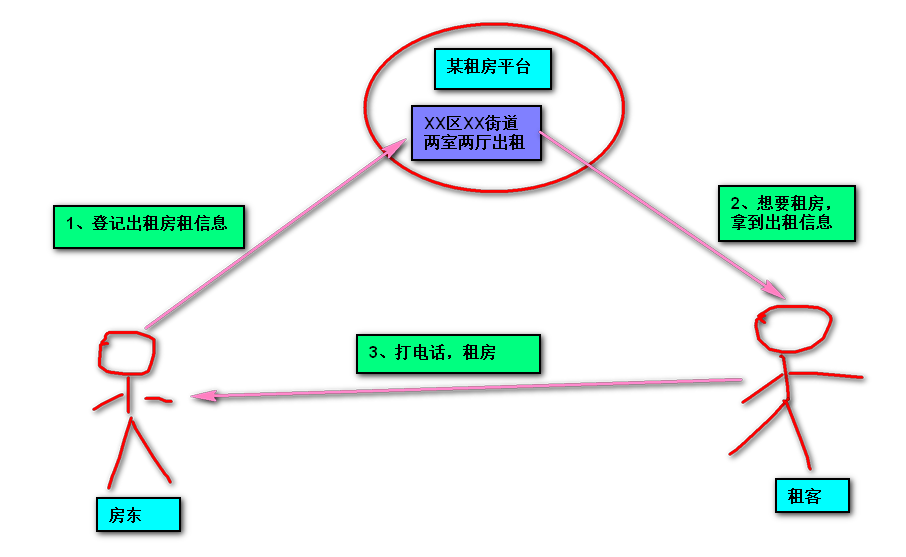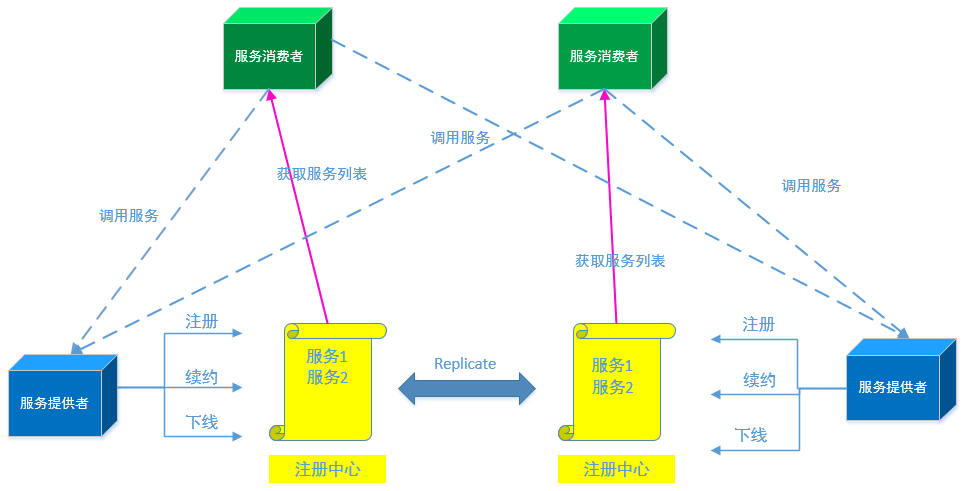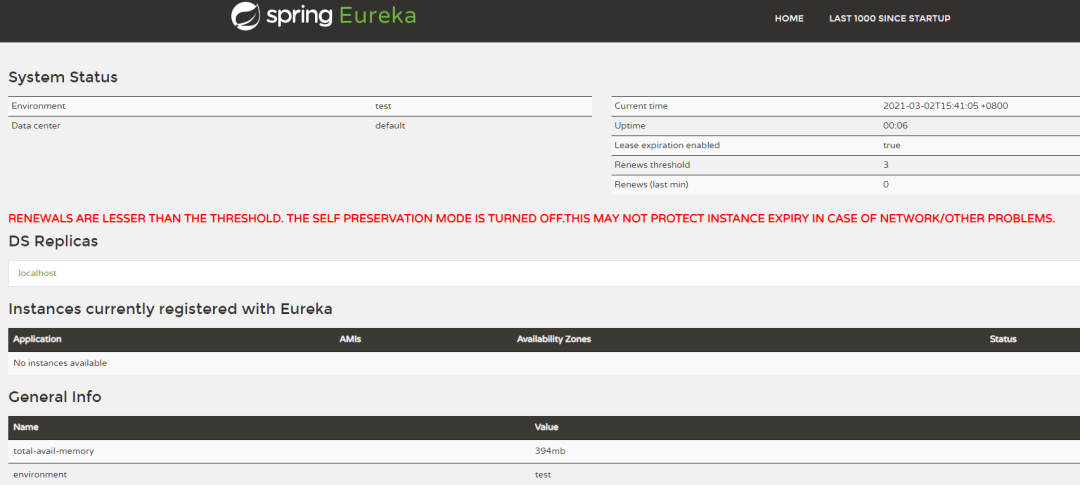说起微服务框架,可能大家首先想到的就是Spring Cloud的大家族了。微服务简单理解就是很小、功能相对集中的服务。在微服务的思想下,原有功能都集中在一起实现的业务,现在拆分出来很多的服务模块,那服务之间的互相调用就不可避免,同时服务的高可用也要能够有所保证。要解决上述需要,少不了微服务中至关重要的内容,即服务治理。
服务治理包括三大组件:服务注册中心、服务的注册、服务的发现。举个例子:就好比我们租房,房东呢,想要把房子租出去;房客想要租房。房东把自己的房子信息挂在租房平台上,房客通过租房平台了解到出租房屋的信息,进而可以给房东打电话租房。

这里呢租房平台就相当于服务注册中心,房东在平台上登记出租房屋相当于房屋的注册,房客从平台上获取出租信息相当于服务的发现。进入到程序的世界,Spring Cloud Eureka组件就提供了服务治理的功能。Eureka的服务端就是注册中心;客户端既可以是消费者也可以是提供者,承担着服务的注册和发现。

简单总结各种解决要提供的主要功能:
服务端:
接收注册。
接收续期。
提供服务下线。
提供服务列表
客户端:
注册服务。
续期。
获取服务列表。
维持心跳。
大体上了解之后,我们就来探索一下在底层是如何实现的。
搭建Eureka环境(单实例环境)
基于Springboot我们可以轻松的搭建Eureka的客户端和服务端。
一、服务端搭建:
引入依赖:
<dependency> <groupId>org.springframework.cloud</groupId> <artifactId>spring-cloud-starter-netflix-eureka-server</artifactId></dependency>
主类上添加注解:
@SpringBootApplication@EnableEurekaServerpublic class EurekaServer_6001 {public static void main(String[] args) {SpringApplication.run(EurekaServer_6001.class, args);}}
在application.properties中相关Eureka的配置:
eureka: instance: hostname: eurekapeer1 #eureka的注册实例名称 client: register-with-eureka: false # 服务注册,不让自己注册到eureka中 fetch-registry: false # 服务的发现 , 自己不从服务中发现信息 service-url: defaultZone: http://localhost:6001/eureka/
启动服务,使用浏览器访问配置的端口,可以看到Eureka的服务端的页面:

二、客户端搭建:
引入依赖:
<dependency> <groupId>org.springframework.cloud</groupId> <artifactId>spring-cloud-starter-netflix-eureka-client</artifactId></dependency>
主类添加注解:
@EnableDiscoveryClient@SpringBootApplicationpublic class ManagerZuulFilter { public static void main(String[] args) { SpringApplication.run(ManagerZuulFilter.class,args); }}
在application.properties中相关Eureka的配置:
eureka: client: register-with-eureka: true #服务注册开关 fetch-registry: true #服务发现开关 serviceUrl: defaultZone: http://localhost:6001/eureka/
启动服务,刷新服务端Eureka的页面,看到客户端服务注册到Eureka的页面。
关闭客户端服务,服务端Eureka的管理页面,客户端的服务从列表中下线。
源码详解
一、客户端源码分析
客户端服务的治理包括:服务的注册、服务的续期、服务的下线、服务列表的发现等。
Eureka的注册和发现的内容在DiscoveryClient类中。
@InjectDiscoveryClient(ApplicationInfoManager applicationInfoManager, EurekaClientConfig config, AbstractDiscoveryClientOptionalArgs args, Provider<BackupRegistry> backupRegistryProvider) {//...省略一些初始化的内容//不注册到Eureka server并且不从Eureka server中获取服务列表,相当于单节点的Eureka服务端if (!config.shouldRegisterWithEureka() && !config.shouldFetchRegistry()) {logger.info("Client configured to neither register nor query for data.");this.scheduler = null;this.heartbeatExecutor = null;this.cacheRefreshExecutor = null;this.eurekaTransport = null;this.instanceRegionChecker = new InstanceRegionChecker(new PropertyBasedAzToRegionMapper(config), this.clientConfig.getRegion());DiscoveryManager.getInstance().setDiscoveryClient(this);DiscoveryManager.getInstance().setEurekaClientConfig(config);this.initTimestampMs = System.currentTimeMillis();logger.info("Discovery Client initialized at timestamp {} with initial instances count: {}", this.initTimestampMs, this.getApplications().size());} else {try {//注册到Eureka并且从Eureka中获取服务列表的逻辑处理this.scheduler = Executors.newScheduledThreadPool(2, (new ThreadFactoryBuilder()).setNameFormat("DiscoveryClient-%d").setDaemon(true).build());//创建心跳定时执行任务this.heartbeatExecutor = new ThreadPoolExecutor(1, this.clientConfig.getHeartbeatExecutorThreadPoolSize(), 0L, TimeUnit.SECONDS, new SynchronousQueue(), (new ThreadFactoryBuilder()).setNameFormat("DiscoveryClient-HeartbeatExecutor-%d").setDaemon(true).build());//创建刷新缓存定时执行任务this.cacheRefreshExecutor = new ThreadPoolExecutor(1, this.clientConfig.getCacheRefreshExecutorThreadPoolSize(), 0L, TimeUnit.SECONDS, new SynchronousQueue(), (new ThreadFactoryBuilder()).setNameFormat("DiscoveryClient-CacheRefreshExecutor-%d").setDaemon(true).build());//注册前处理器,可以在服务注册到Eureka之前做些操作if (this.preRegistrationHandler != null) {this.preRegistrationHandler.beforeRegistration();}//是否强制初始阶段就注册到Eurekaif (this.clientConfig.shouldRegisterWithEureka() && this.clientConfig.shouldEnforceRegistrationAtInit()) {try {if (!this.register()) {throw new IllegalStateException("Registration error at startup. Invalid server response.");}} catch (Throwable var8) {logger.error("Registration error at startup: {}", var8.getMessage());throw new IllegalStateException(var8);}}//执行定时任务this.initScheduledTasks();try {Monitors.registerObject(this);} catch (Throwable var7) {logger.warn("Cannot register timers", var7);}DiscoveryManager.getInstance().setDiscoveryClient(this);DiscoveryManager.getInstance().setEurekaClientConfig(config);this.initTimestampMs = System.currentTimeMillis();logger.info("Discovery Client initialized at timestamp {} with initial instances count: {}", this.initTimestampMs, this.getApplications().size());}}//初始化定时任务private void initScheduledTasks() {int renewalIntervalInSecs;int expBackOffBound;//定时获取服务列表任务开启if (this.clientConfig.shouldFetchRegistry()) {renewalIntervalInSecs = this.clientConfig.getRegistryFetchIntervalSeconds();expBackOffBound = this.clientConfig.getCacheRefreshExecutorExponentialBackOffBound();this.scheduler.schedule(new TimedSupervisorTask("cacheRefresh", this.scheduler, this.cacheRefreshExecutor, renewalIntervalInSecs, TimeUnit.SECONDS, expBackOffBound, new DiscoveryClient.CacheRefreshThread()), (long)renewalIntervalInSecs, TimeUnit.SECONDS);}//注册到Eureka,心跳定时任务开始。要让Eureka Server知道客户端还活着if (this.clientConfig.shouldRegisterWithEureka()) {renewalIntervalInSecs = this.instanceInfo.getLeaseInfo().getRenewalIntervalInSecs();expBackOffBound = this.clientConfig.getHeartbeatExecutorExponentialBackOffBound();logger.info("Starting heartbeat executor: renew interval is: {}", renewalIntervalInSecs);this.scheduler.schedule(new TimedSupervisorTask("heartbeat", this.scheduler, this.heartbeatExecutor, renewalIntervalInSecs, TimeUnit.SECONDS, expBackOffBound, new DiscoveryClient.HeartbeatThread()), (long)renewalIntervalInSecs, TimeUnit.SECONDS);this.instanceInfoReplicator = new InstanceInfoReplicator(this, this.instanceInfo, this.clientConfig.getInstanceInfoReplicationIntervalSeconds(), 2);this.statusChangeListener = new StatusChangeListener() {public String getId() {return "statusChangeListener";}public void notify(StatusChangeEvent statusChangeEvent) {if (InstanceStatus.DOWN != statusChangeEvent.getStatus() && InstanceStatus.DOWN != statusChangeEvent.getPreviousStatus()) {DiscoveryClient.logger.info("Saw local status change event {}", statusChangeEvent);} else {DiscoveryClient.logger.warn("Saw local status change event {}", statusChangeEvent);}DiscoveryClient.this.instanceInfoReplicator.onDemandUpdate();}};if (this.clientConfig.shouldOnDemandUpdateStatusChange()) {this.applicationInfoManager.registerStatusChangeListener(this.statusChangeListener);}this.instanceInfoReplicator.start(this.clientConfig.getInitialInstanceInfoReplicationIntervalSeconds());} else {logger.info("Not registering with Eureka server per configuration");}}//注册发送,REST请求,注册服务到Eureka Server中。boolean register() throws Throwable {logger.info("DiscoveryClient_{}: registering service...", this.appPathIdentifier);EurekaHttpResponse httpResponse;try {httpResponse = this.eurekaTransport.registrationClient.register(this.instanceInfo);} catch (Exception var3) {logger.warn("DiscoveryClient_{} - registration failed {}", new Object[]{this.appPathIdentifier, var3.getMessage(), var3});throw var3;}if (logger.isInfoEnabled()) {logger.info("DiscoveryClient_{} - registration status: {}", this.appPathIdentifier, httpResponse.getStatusCode());}return httpResponse.getStatusCode() == 204;}
查看线程,发现确实有上述几类线程。

二、服务端源码分析
服务端的主要逻辑就是:接收客户端的注册/续期/下线等请求、提供服务列表、维护注册信息等。
#eureka server端的功能代码主要是在eureka-core包中主要涉及类和接口有:
EurekaServerBootstrap
InstanceRegistry
下面主要为大家讲一下客户端注册在服务端如何处理:eureka-server包下org.springframework.cloud.netflix.eureka.server.EurekaServerBootstrap初始化eurekserver相关的内容:
public class EurekaServerBootstrap { public void contextInitialized(ServletContext context) { try { this.initEurekaEnvironment();//初始化eureka的部署环境,默认test this.initEurekaServerContext();//初始化eureka server的上下文 context.setAttribute(EurekaServerContext.class.getName(), this.serverContext); } catch (Throwable var3) { log.error("Cannot bootstrap eureka server :", var3); throw new RuntimeException("Cannot bootstrap eureka server :", var3); } }}
eureka-server包下的org.springframework.cloud.netflix.eureka.server.InstanceRegistry中方法为跟服务治理有关系的内容。
public class InstanceRegistry extends PeerAwareInstanceRegistryImpl implements ApplicationContextAware {public void register(InstanceInfo info, int leaseDuration, boolean isReplication) {this.handleRegistration(info, leaseDuration, isReplication);super.register(info, leaseDuration, isReplication);//带有租期的注册,默认租期90s}}public abstract class AbstractInstanceRegistry implements InstanceRegistry {//存放注册到eureka server上的服务的数据接口//第一层的String key是指服务名//第二层的String key是指每个服务的instanceId:默认hostmame:applicationName:port//最里面的InstanceInfo就是一个服务的详细信息private final ConcurrentHashMap<String, Map<String, Lease<InstanceInfo>>> registry = new ConcurrentHashMap();//客户端注册到服务端的具体处理过程public void register(InstanceInfo registrant, int leaseDuration, boolean isReplication) {try {this.read.lock();//该Map存储的就是eureka server上的服务信息//根据应用名获取该应用名下的列表Map<String, Lease<InstanceInfo>> gMap = (Map)this.registry.get(registrant.getAppName());EurekaMonitors.REGISTER.increment(isReplication);if (gMap == null) {//没有注册过,则新创建ConcurrentHashMap<String, Lease<InstanceInfo>> gNewMap = new ConcurrentHashMap();gMap = (Map)this.registry.putIfAbsent(registrant.getAppName(), gNewMap);if (gMap == null) {gMap = gNewMap;}}//通过instanceId获取具体的服务Lease<InstanceInfo> existingLease = (Lease)((Map)gMap).get(registrant.getId());if (existingLease != null && existingLease.getHolder() != null) {Long existingLastDirtyTimestamp = ((InstanceInfo)existingLease.getHolder()).getLastDirtyTimestamp();Long registrationLastDirtyTimestamp = registrant.getLastDirtyTimestamp();logger.debug("Existing lease found (existing={}, provided={}", existingLastDirtyTimestamp, registrationLastDirtyTimestamp);if (existingLastDirtyTimestamp > registrationLastDirtyTimestamp) {logger.warn("There is an existing lease and the existing lease's dirty timestamp {} is greater than the one that is being registered {}", existingLastDirtyTimestamp, registrationLastDirtyTimestamp);logger.warn("Using the existing instanceInfo instead of the new instanceInfo as the registrant");registrant = (InstanceInfo)existingLease.getHolder();}} else {synchronized(this.lock) {if (this.expectedNumberOfRenewsPerMin > 0) {this.expectedNumberOfRenewsPerMin += 2;this.numberOfRenewsPerMinThreshold = (int)((double)this.expectedNumberOfRenewsPerMin * this.serverConfig.getRenewalPercentThreshold());}}logger.debug("No previous lease information found; it is new registration");}//创建新的租期信息Lease<InstanceInfo> lease = new Lease(registrant, leaseDuration);if (existingLease != null) {lease.setServiceUpTimestamp(existingLease.getServiceUpTimestamp());}//注册服务或者更新服务((Map)gMap).put(registrant.getId(), lease);synchronized(this.recentRegisteredQueue) {this.recentRegisteredQueue.add(new Pair(System.currentTimeMillis(), registrant.getAppName() + "(" + registrant.getId() + ")"));}if (!InstanceStatus.UNKNOWN.equals(registrant.getOverriddenStatus())) {logger.debug("Found overridden status {} for instance {}. Checking to see if needs to be add to the overrides", registrant.getOverriddenStatus(), registrant.getId());if (!this.overriddenInstanceStatusMap.containsKey(registrant.getId())) {logger.info("Not found overridden id {} and hence adding it", registrant.getId());this.overriddenInstanceStatusMap.put(registrant.getId(), registrant.getOverriddenStatus());}}InstanceStatus overriddenStatusFromMap = (InstanceStatus)this.overriddenInstanceStatusMap.get(registrant.getId());if (overriddenStatusFromMap != null) {logger.info("Storing overridden status {} from map", overriddenStatusFromMap);registrant.setOverriddenStatus(overriddenStatusFromMap);}InstanceStatus overriddenInstanceStatus = this.getOverriddenInstanceStatus(registrant, existingLease, isReplication);registrant.setStatusWithoutDirty(overriddenInstanceStatus);if (InstanceStatus.UP.equals(registrant.getStatus())) {lease.serviceUp();}registrant.setActionType(ActionType.ADDED);this.recentlyChangedQueue.add(new AbstractInstanceRegistry.RecentlyChangedItem(lease));registrant.setLastUpdatedTimestamp();this.invalidateCache(registrant.getAppName(), registrant.getVIPAddress(), registrant.getSecureVipAddress());logger.info("Registered instance {}/{} with status {} (replication={})", new Object[]{registrant.getAppName(), registrant.getId(), registrant.getStatus(), isReplication});} finally {this.read.unlock();}}}
配置类
常用配置说明:客户端、服务端、以及实例配置可以直接在配置类的属性中查到:
客户端配置:前缀为eureka.client
org.springframework.cloud.netflix.eureka.EurekaClientConfigBean
服务端配置:前缀为eureka.server
org.springframework.cloud.netflix.eureka.server.EurekaServerConfigBean
实例配置:前缀eureka.instance
org.springframework.cloud.netflix.eureka.EurekaInstanceConfigBean
常用配置
注册中心配置:
#关闭注册中心的保护机制,Eureka 会统计15分钟之内心跳失败的比例低于85%将会触发保护机制,不剔除服务提供者eureka.server.enable-self-preservation = false
服务实例配置:
#不使用主机名来定义注册中心的地址,而使用IP地址的形式eureka.instance.prefer-ip-address = true
服务注册类配置:
#获取服务注册列表eureka.client.fetch-registery = true#注册服务到Eureka Servereureka.client.register-with-eureka = true#从Eureka服务器端获取注册信息的间隔时间,单位:秒eureka.client.registery-fetch-interval-seconds = 30#读取EurekaServer信息的超时时间,单位:秒eureka.client.eureka-server-read-timeout-seconds = 8#连接EurekaServer的超时时间,单位:秒eureka.client.eureka-server-connect-timeout-seconds = 5
通用配置:
eureka.client.service-url.defaultZone = http://localhost:8761/eureka
Spring cloud Eureka中还提供了其他的一些功能,比如认证和限流的内容,有兴趣的可以了解一下。除Eureka提供的服务治理外,还有其他的框架也可以实现服务治理,如Dubbo+Zookeeper,有兴趣可以对比看一下。
框架可以算是一种工具,了解工具的内部是为了更好的让工具为我们服务。优秀框架的设计思想是我们要学习的重点,抽丝剥茧之后,原理其实很基础。